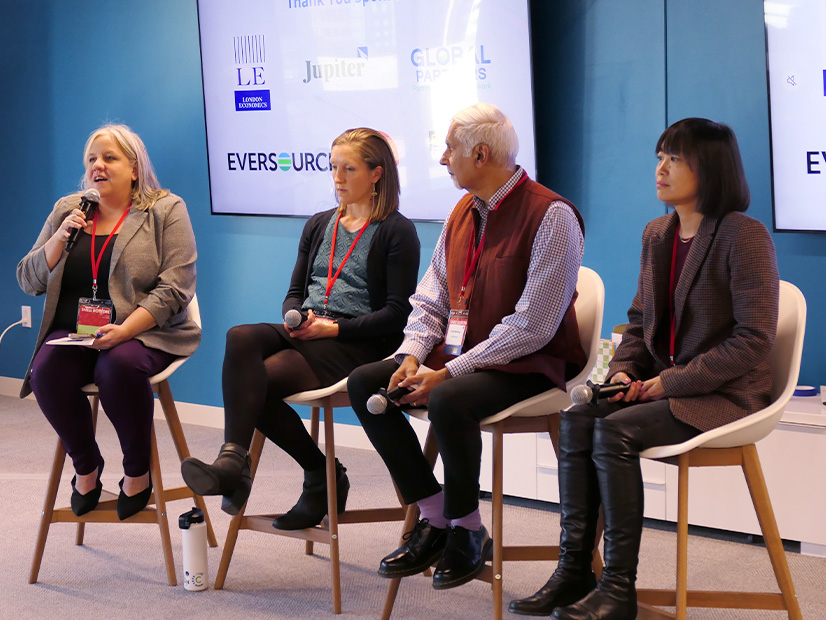
BOSTON — Massachusetts lawmakers and industry members must double down on efforts to rapidly scale up new renewable technologies to meet the needs of the energy transition, speakers at the Northeast Energy and Commerce Association’s Energy Innovation Forum on Nov. 14 emphasized.
“If there is one aspect of this work that truly worries me, it is not innovation; … it is deployment,” said Ben Downing, vice president of public affairs for The Engine Accelerator, a public benefit corporation spun out of the Massachusetts Institute of Technology in 2016.
Downing spoke optimistically about the “cavalry of new solutions coming in waves” to help the clean energy transition, including nuclear fusion, deep geothermal energy, long-duration energy storage and superconducting transmission lines.
But even with solutions on the horizon, “I worry about our ability to deploy with the combination of speed and scale that is required,” Downing said. “Getting those concepts to commercialization is on all of us.”
In the power sector, utilities and regulators will need to evolve their approach to new technologies, said Sarah Cullinan, senior director of the Net Zero Grid Program at the Massachusetts Clean Energy Center.
“Our utilities are very open to innovation, but the landscape and the process make it really difficult,” she said. “The scale aspect for utilities is entirely determined within the Department of Public Utilities, and it’s ultimately ratepayers that would fund the full-scale deployment of any new technology.”
Utilities have “very little room for error” in deploying new technologies, Cullinan said, adding that “the question is how do you test something on that system in a way that gives you the data and information that you need without compromising reliability.”
Cullinan specifically cited grid-enhancing technologies as a key area of potential technological improvement on the distribution side, especially as they have gained traction in transmission applications.
“I’m hoping that some of that can be scaled to distribution,” Cullinan said.
Downing expressed hope that the changes to clean energy siting and permitting recently passed by the Massachusetts legislature would help expedite the deployment of new resources. (See Compromise Climate Bill Finally Approved by Mass. Legislature.)
However, Jenny Liu of Jupiter Power stressed that interconnection backlogs still pose a major hurdle to development in the region.
“It’s just taking too long to get through the process, and therefore, we can’t deploy [renewables] to solve the capacity deficiency pretty much everywhere,” Liu said. “This is a big problem; only if we get it solved will there be a big breakthrough in the renewable energy industry.” (See related story, Stakeholders Push for More Interconnection Rule Changes at FERC.)
While FERC Order 2023 requires major changes to interconnection procedures across the country, the commission has yet to rule on RTO compliance filings, creating significant uncertainty for New England developers. (See New England Clean Energy Developers Struggle with Order 2023 Uncertainty.)
On the consumer-facing side, the industry must work to educate and prepare customers for the rollout of advanced metering infrastructure (AMI) and time-varying rates, Cullinan said. Eversource Energy, one of the two major electric utility companies in Massachusetts, has said it will start deploying advanced meters in the state in 2025.
Vinit Nijhawan, managing director of MassVentures, said the state must find a way to move faster to implement time-varying rates.
“It’s not about the technology,” Nijhawan said. “We’ve been talking about time-of-day rates for as long as I’ve been here, which is 37 years.
“We’ve got to move faster than we’re moving. … We need imagination.”
At the same time, Nijhawan praised the state’s overall climate of fostering innovation.
“Massachusetts is the most amazing place for new ideas to flourish. We don’t need to change much; I think it’s all there,” he said.
Regarding the potential effects of a second Trump administration on the state’s clean energy transition, Cullinan said there is “a lot of uncertainty” about the availability of federal funding going forward.
“Across the entire state that question is popping up. There really is an effort to figure out what is at risk,” she said. “Luckily, we live in a state where there is a lot of funding and support still.”



